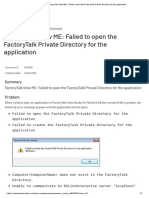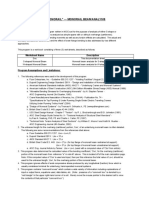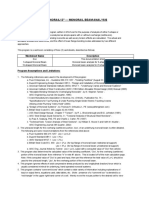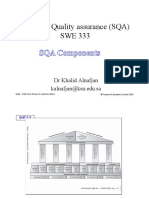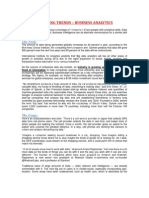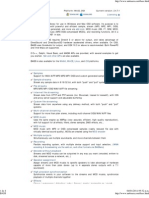MONORAIL13
MONORAIL13
Uploaded by
ankit kadamCopyright:
Available Formats
MONORAIL13
MONORAIL13
Uploaded by
ankit kadamCopyright
Available Formats
Share this document
Did you find this document useful?
Is this content inappropriate?
Copyright:
Available Formats
MONORAIL13
MONORAIL13
Uploaded by
ankit kadamCopyright:
Available Formats
"MONORAIL13" --- MONORAIL BEAM ANALYSIS
Program Description:
"MONORAIL13" is a spreadsheet program written in MS-Excel for the purpose of analysis of either S-shape or
W-shape underhung monorail beams analyzed as simple-spans with or without overhangs (cantilevers).
Specifically, the x-axis and y-axis bending moments as well as any torsion effects are calculated. The actual and
allowable stresses are determined, and the effect of lower flange bending is also addressed by two different
approaches.
This program is a workbook consisting of three (3) worksheets, described as follows:
Worksheet Name Description
Doc This documentation sheet
S-shaped Monorail Beam Monorail beam analysis for S-shaped beams
W-shaped Monorail Beam Monorail beam analysis for W-shaped beams
Program Assumptions and Limitations:
1. The following references were used in the development of this program:
a. Fluor Enterprises, Inc. - Guideline 000.215.1257 - "Hoisting Facilities" (August 22, 2005)
b. Dupont Engineering Design Standard: DB1X - "Design and Installation of Monorail Beams" (May 2000)
c. American National Standards Institute (ANSI): MH27.1 - "Underhung Cranes and Monorail Syatems"
d. American Institute of Steel Construction (AISC) 13th Edition Allowable Stress Design (ASD) Manual (2005)
e. "Allowable Bending Stresses for Overhanging Monorails" - by N. Stephen Tanner -
AISC Engineering Journal (3rd Quarter, 1985)
f. Crane Manufacturers Association of America, Inc. (CMAA) - Publication No. 74 -
"Specifications for Top Running & Under Running Single Girder Electric Traveling Cranes
Utilizing Under Running Trolley Hoist" (2004)
g. "Design of Monorail Systems" - by Thomas H. Orihuela Jr., PE (www.pdhengineer.com)
h. British Steel Code B.S. 449, pages 42-44 (1959)
i. USS Steel Design Manual - Chapter 7 "Torsion" - by R. L. Brockenbrough and B.G. Johnston (1981)
j. AISC Steel Design Guide Series No. 9 - "Torsional Analysis of Structural Steel Members" -
by Paul A. Seaburg, PhD, PE and Charlie J. Carter, PE (1997)
k. "Technical Note: Torsion Analysis of Steel Sections" - by William E. Moore II and Keith M. Mueller -
AISC Engineering Journal (4th Quarter, 2002)
2. The unbraced length for the overhang (cantilever) portion, 'Lbo', of an underhung monorail beam is often debated.
The following are some recommendations from the references cited above:
a. Fluor Guideline 000.215.1257: Lbo = Lo+L/2
b. Dupont Standard DB1X: Lbo = 3*Lo
c. ANSI Standard MH27.1: Lbo = 2*Lo
d. British Steel Code B.S. 449: Lbo = 2*Lo (for top flange of monorail beam restrained at support)
British Steel Code B.S. 449: Lbo = 3*Lo (for top flange of monorail beam unrestrained at support)
e. AISC Eng. Journal Article by Tanner: Lbo = Lo+L (used with a computed value of 'Cbo' from article)
3. This program also determines the calculated value of the bending coefficient, 'Cbo', for the overhang (cantilever)
portion of the monorail beam from reference "e" in note #1 above. This is located off of the main calculation page.
Note: if this computed value of 'Cbo' is used and input, then per this reference the total value of Lo+L should be
used for the unbraced length, 'Lbo', for the overhang portion of the monorail beam.
4. This program ignores effects of axial compressive stress produced by any longitudinal (traction) force which is
usually considered minimal for underhung, hand-operated monorail systems.
5. This program contains “comment boxes” which contain a wide variety of information including explanations of
input or output items, equations used, data tables, etc. (Note: presence of a “comment box” is denoted by a
“red triangle” in the upper right-hand corner of a cell. Merely move the mouse pointer to the desired cell to view
the contents of that particular "comment box".)
"MONORAIL13.xls" Program
Created By: Joel Berg, P.E.
Based on a Spreadsheet By: Alex Tomanovich, P.E.
Version 1.3
MONORAIL BEAM ANALYSIS
For S-shaped Underhung Monorails Analyzed as Simple-Spans with / without Overhang
Per AISC 13th Edition ASD Manual and CMAA Specification No. 74 (2004)
Project Name: Client: ###
Project No.: Prep. By: Date: ###
###
Input: ###
RL(min)=-0.73 kips RR(max)=9.13 kips ta =
Monorail Size: L=17 ft. Lo=3 ft. l=
Select: S12x50 x=8.313ft. Cxo =
Design Parameters: S=9 in. Cx1 =
Beam Fy = 36 ksi Czo =
Beam Simple-Span, L = 17.0000 ft. S12x50 Cz1 =
Unbraced Length, Lb = 17.0000 ft. Section Ratios and P
Bending Coef., Cb = 1.00 Pv=7.4 kips bf/(2*tf) =
Overhang Length, Lo = 3.0000 ft. Nomenclature h/tw =
Unbraced Length, Lbo = 11.5000 ft. Shape Factor X =
Bending Coef., Cbo = 1.00 S12x50 Member Properties:
Lifted Load, P = 6.000 kips A = 14.60 in.^2 Zx = 60.90 in.^3
Trolley Weight, Wt = 0.400 kips d = 12.000 in. Iy = 15.60 in.^4
Hoist Weight, Wh = 0.100 kips tw = 0.687 in. Sy = 5.69 in.^3
Vert. Impact Factor, Vi = 15 % bf = 5.480 in. ry = 1.030 in.
Horz. Load Factor, HLF = 10 % tf = 0.659 in. Zy = 10.30 in.^3
Total No. Wheels, Nw = 4 k= 1.440 in. J = 2.770 in.^4
Wheel Spacing, S = 9.0000 in. Ix = 303.00 in.^4 Cw = 501.0 in.^6
Distance on Flange, a = 0.3750 in. Sx = 50.60 in.^3 wt / ft. = 50.0 plf
For Lo > 0 (with ove
Support Reactions: (with overhang) RR(max) =
Results: RR(max) = 9.13 RL(min) =
= Pv*(L+(Lo-(S/12)/2))/L+w/1000/(2*L)*(L+Lo)^2
RL(min) = -0.73 = -Pv*(Lo-(S/12)/2)/L+w/1000/(2*L)*(L^2-Lo^2) Bending Moments fo
Parameters and Coefficients: x=
Pv = 7.400 kips Pv = P*(1+Vi/100)+Wt+Wh (vertical load) Mx =
Pw = 1.850 kips/wheel Pw = Pv/Nw (load per trolley wheel) My =
Ph = 0.600 kips Ph = HLF*P (horizontal load) Lateral Flange Bend
ta = 0.493 in. ta = tf-bf/24+a/6 (for S-shape) e=
l = 0.156 l = 2*a/(bf-tw) at =
Cxo = -0.850 Cxo = -1.096+1.095*l+0.192*e^(-6.0*l) Mt =
Cx1 = 0.600 Cx1 = 3.965-4.835*l-3.965*e^(-2.675*l)
Czo = 0.165 Czo = -0.981-1.479*l+1.120*e^(1.322*l) Design Chapter
Cz1 = 1.948 Cz1 = 1.810-1.150*l+1.060*e^(-7.70*l) kc =
Bending Moments for Simple-Span: Lp =
x = 8.313 ft. x = 1/2*(L-(S/12)/2) (location of max. moments from left end of simple-span) rts =
Mx = 31.88 ft-kips Mx = (Pv/2)/(2*L)*(L-(S/12)/2)^2+w/1000*x/2*(L-x) c=
My = 2.44 ft-kips My = (Ph/2)/(2*L)*(L-(S/12)/2)^2 R1 =
R2 =
Lateral Flange Bending Moment from Torsion for Simple-Span: (per USS Steel Design Manual, 1981) Lr =
e = 6.000 in. e = d/2 (assume horiz. load taken at bot. flange) R3 =
at = 21.641 at = SQRT(E*Cw/(J*G)) , E=29000 ksi and G=11200 ksi fbx =
Mt = 0.29 ft-kips Mt = Ph*e*at/(2*(d-tf))*TANH(L*12/(2*at))/12 Is Lb<=Lp?
Fbx =
X-axis Stresses for Simple-Span: Fbx =
fbx = 7.56 ksi fbx = Mx/Sx Fbx =
Lr = 24.91 ft. (Eqn. F2-6, max. value of Lb for inelastic LTB) Use: Fbx =
Fbx = 19.25 ksi Eqn. F2-2 Controls fbx <= Fbx, O.K.
(continued)
03/11/2020 file:///conversion/tmp/scratch/464382037.xls Page 3
15:34:15 464382037.xls of 8
"MONORAIL13.xls" Program
Created By: Joel Berg, P.E.
Based on a Spreadsheet By: Alex Tomanovich, P.E.
Version 1.3
Y-axis Stresses for Simple-Span: fby =
fby = 5.14 ksi fby = My/Sy fwns =
fwns = 1.21 ksi fwns = Mt*12/(Sy/2) (warping normal stress) fby(total) =
fby(total) = 6.35 ksi fby(total) = fby+fwns Fby =
Fby = 34.49 ksi Eqn. F6-1 Controls fby <= Fby, O.K.
Fby =
Combined Stress Ratio for Simple-Span: Fcr =
S.R. = 0.577 S.R. = fbx/Fbx+fby(total)/Fby S.R. <= 1.0, O.K.
Vertical Deflection for Simple-Span: S.R. =
Pv = 6.500 kips Pv = P+Wh+Wt (without vertical impact)
D (max) = 0.1412 in. D(max) = Pv/2*(L-S)/2/(24*E*I)*(3*L^2-4*((L-S/12)/2)^2)+5*w/12000*L^4/(384*E*I)
Pv =
D(ratio) = L/1445 D(ratio) = L*12/D(max) D(max) =
D(allow) = 0.4533 in. D(allow) = L*12/450 Defl.(max) <= Defl.(allow), O.K.
D(allow) =
Bending Moments for Overhang:
Mx = 19.65 ft-kips Mx = (Pv/2)*(Lo+(Lo-S))+w/1000*Lo^2/2 Mx =
My = 1.58 ft-kips My = (Ph/2)*(Lo+(Lo-S)) My =
Lateral Flange Bend
Lateral Flange Bending Moment from Torsion for Overhang: (per USS Steel Design Manual, 1981) e =
e = 6.000 in. e = d/2 (assume horiz. load taken at bot. flange) at =
at = 21.641 at = SQRT(E*Cw/(J*G)) , E=29000 ksi and G=11200 ksi Mt =
Mt = 0.57 ft-kips Mt = Ph*e*at/(d-tf)*TANH(Lo*12/at)/12
Design Chapter
X-axis Stresses for Overhang: kc =
fbx = 4.66 ksi fbx = Mx/Sx Lp =
Lr = 24.91 ft. (Eqn. F2-6, max. value of Lb for inelastic LTB) rts =
Fbx = 22.15 ksi Eqn. F2-2 Controls fbx <= Fbx, O.K.
R1 =
Y-axis Stresses for Overhang: R2 =
fby = 3.32 ksi fby = My/Sy Lr =
fwns = 2.41 ksi fwns = Mt*12/(Sy/2) (warping normal stress) R3 =
fby(total) = 5.74 ksi fby(total) = fby+fwns fbx =
Fby = 34.49 ksi Eqn. F6-1 Controls fby <= Fby, O.K.
Fbx =
Combined Stress Ratio for Overhang: Fbx =
S.R. = 0.377 S.R. = fbx/Fbx+fby(total)/Fby S.R. <= 1.0, O.K.
Use: Fbx =
Vertical Deflection for Overhang: (assuming full design load, Pv without impact, at end of overhang) Mrx =
Pv = 6.500 kips Pv = P+Wh+Wt (without vertical impact) S.R. =
D(max) = 0.0715 in. D(max) = Pv*Lo^2*(L+Lo)/(3*E*I)+w/12000*Lo*(4*Lo^2*L-L^3+3*Lo^3)/(24*E*I)
D(ratio) = L/503 D(ratio) = Lo*12/D(max) fby =
D(allow) = 0.0800 in. D(allow) = Lo*12/450 Defl.(max) <= Defl.(allow), O.K.
fby(total) =
Bottom Flange Bending (simplified): Fby =
be = 7.908 in. Min. of: be = 12*tf or S (effective flange bending length) Fby =
tf2 = 0.859 in. tf2 = tf+(bf/2-tw/2)/2*(1/6) (flange thk. at web based on 1:6 slope of flange) Fby =
am = 1.815 in. am = (bf/2-tw/2)-(k-tf2) (where: k-tf2 = radius of fillet) Fcr =
Mf = 2.664 in.-kips Mf = Pw*(am-a) Use: Fby =
Sf = 0.572 in.^3 Sf = be*tf^2/6
fb = 4.65 ksi fb = Mf/Sf S.R. =
Fb = 32.40 ksi Fb = 0.9*Fy fb <= Fb, O.K.
Pv =
(continued)
03/11/2020 file:///conversion/tmp/scratch/464382037.xls Page 4
15:34:15 464382037.xls of 8
"MONORAIL13.xls" Program
Created By: Joel Berg, P.E.
Based on a Spreadsheet By: Alex Tomanovich, P.E.
Version 1.3
D(ratio) =
Bottom Flange Bending per CMAA Specification No. 74 (2004): (Note: torsion is neglected) D(allow) =
Local Flange Bending Stress @ Point 0: (Sign convention: + = tension, - = compression)
s xo = -6.46 ksi sxo = Cxo*Pw/ta^2 be =
szo = 1.25 ksi szo = Czo*Pw/ta^2 tf2 =
S-shape am =
Local Flange Bending Stress @ Point 1: Mf =
sx1 = 4.56 ksi sx1 = Cx1*Pw/ta^2 Trolley Sf =
sz1 = 14.82 ksi sz1 = Cz1*Pw/ta^2 Wheel fb =
Fb =
Local Flange Bending Stress @ Point 2: Bottom Flange Bend
sx2 = 6.46 ksi sx2 = -sxo Local Flange Bendin
sz2 = -1.25 ksi sz2 = -szo Pw Pw sxo =
szo =
Resultant Biaxial Stress @ Point 0:
fbxo = 7.56 ksi fbxo = Mx*(d/2)/Ix = Mx/Sx sx1 =
fbyo = 0.64 ksi fbyo = My*(tw/2)/Iy sz1 =
sz = 9.15 ksi sz = fbxo+fbyo+0.75*szo
sx = -4.85 ksi sx = 0.75*sxo sx2 =
t xz = 0.00 ksi txz = 0 (assumed negligible) sz2 =
sto = 12.31 ksi sto = SQRT(sx^2+sz^2-sx*sz+3*txz^2) <= Fb = 0.66*Fy = 23.76 ksi, O.K.
fbxo =
Resultant Biaxial Stress @ Point 1: fbyo =
fbx1 = 7.56 ksi fbx1 = Mx*(d/2)/Ix = Mx/Sx sz =
fby1 = 4.44 ksi fby1 = My*(bf/2-a)/Iy sx =
sz = 23.11 ksi sz = fbx1+fby1+0.75*sz1 txz =
sx = 3.42 ksi sx = 0.75*sx1 sto =
txz = 0.00 ksi txz = 0 (assumed negligible)
st1 = 21.60 ksi st1 = SQRT(sx^2+sz^2-sx*sz+3*txz^2) <= Fb = 0.66*Fy = 23.76 ksi, O.K.
fby1 =
Resultant Biaxial Stress @ Point 2: sz =
fbx2 = 6.74 ksi fbx2 = Mx*(d/2-tf)/Ix sx =
fby2 = 0.64 ksi fby2 = My*(tw/2)/Iy txz =
sz = 6.45 ksi sz = fbx2+fby2+0.75*sz2 st1 =
sx = 4.85 ksi sx = 0.75*sx2
txz = 0.00 ksi txz = 0 (assumed negligible) fbx2 =
st2 = 5.81 ksi st2 = SQRT(sx^2+sz^2-sx*sz+3*txz^2) <= Fb = 0.66*Fy = 23.76 ksi, O.K.
sz =
Y sx =
txz =
st2 =
tw
X
Pw Z Pw
tf
Point 2 Point 1 ta
bf/4
Point 0 tw/2 bf
03/11/2020 file:///conversion/tmp/scratch/464382037.xls Page 5
15:34:15 464382037.xls of 8
"MONORAIL13.xls" Program
Created By: Joel Berg, P.E.
Based on a Spreadsheet By: Alex Tomanovich, P.E.
Version 1.3
MONORAIL BEAM ANALYSIS
For W-shaped Underhung Monorails Analyzed as Simple-Spans with / without Overhang
Per AISC 13th Edition ASD Manual and CMAA Specification No. 74 (2004)
Project Name: Client: ###
Project No.: Prep. By: Date: ###
###
Input: ###
RL(min)=-0.73 kips RR(max)=9.13 kips ta =
Monorail Size: L=17 ft. Lo=3 ft. l=
Select: W12x50 x=8.313 ft Cxo =
Design Parameters: S=9 in. Cx1 =
Beam Fy = 36 ksi Czo =
Beam Simple-Span, L = 17.0000 ft. W12x50 Cz1 =
Unbraced Length, Lb = 17.0000 ft. Section Ratios and P
Bending Coef., Cb = 1.00 Pv=7.4 kips bf/(2*tf) =
Overhang Length, Lo = 3.0000 ft. Nomenclature h/tw =
Unbraced Length, Lbo = 11.5000 ft. Shape Factor X =
Bending Coef., Cbo = 1.00 W12x50 Member Properties:
Lifted Load, P = 6.000 kips A = 14.60 in.^2 Zx = 71.90 in.^3
Trolley Weight, Wt = 0.400 kips d = 12.200 in. Iy = 56.30 in.^4
Hoist Weight, Wh = 0.100 kips tw = 0.370 in. Sy = 13.90 in.^3
Vert. Impact Factor, Vi = 15 % bf = 8.080 in. ry = 1.960 in.
Horz. Load Factor, HLF = 10 % tf = 0.640 in. Zy = 21.30 in.^3
Total No. Wheels, Nw = 4 k= 1.140 in. J = 1.710 in.^4
Wheel Spacing, S = 9.0000 in. Ix = 391.00 in.^4 Cw = 1880.0 in.^6
Distance on Flange, a = 0.3750 in. Sx = 64.20 in.^3 wt / ft. = 50.0 plf
For Lo > 0 (with ove
Support Reactions: (with overhang) RR(max) =
Results: RR(max) = 9.13 RL(min) =
= Pv*(L+(Lo-(S/12)/2))/L+w/1000/(2*L)*(L+Lo)^2
RL(min) = -0.73 = -Pv*(Lo-(S/12)/2)/L+w/1000/(2*L)*(L^2-Lo^2) Bending Moments fo
Parameters and Coefficients: x=
Pv = 7.400 kips Pv = P*(1+Vi/100)+Wt+Wh (vertical load) Mx =
Pw = 1.850 kips/wheel Pw = Pv/Nw (load per trolley wheel) My =
Ph = 0.600 kips Ph = HLF*P (horizontal load) Lateral Flange Bend
ta = 0.640 in. ta = tf (for W-shape) e=
l = 0.097 l = 2*a/(bf-tw) at =
Cxo = -1.903 Cxo = -2.110+1.977*l+0.0076*e^(6.53*l) Mt =
Cx1 = 0.535 Cx1 = 10.108-7.408*l-10.108*e^(-1.364*l) X-axis Stresses for
Czo = 0.192 Czo = 0.050-0.580*l+0.148*e^(3.015*l) Design Chapter
Cz1 = 2.319 Cz1 = 2.230-1.490*l+1.390*e^(-18.33*l) kc =
Bending Moments for Simple-Span: Lp =
x = 8.313 ft. x = 1/2*(L-(S/12)/2) (location of max. moments from left end of simple-span) rts =
Mx = 31.88 ft-kips Mx = (Pv/2)/(2*L)*(L-(S/12)/2)^2+w/1000*x/2*(L-x) c=
My = 2.44 ft-kips My = (Ph/2)/(2*L)*(L-(S/12)/2)^2 R1 =
R2 =
Lateral Flange Bending Moment from Torsion for Simple-Span: (per USS Steel Design Manual, 1981) Lr =
e = 6.100 in. e = d/2 (assume horiz. load taken at bot. flange) R3 =
at = 53.354 at = SQRT(E*Cw/(J*G)) , E=29000 ksi and G=11200 ksi fbx =
Mt = 0.67 ft-kips Mt = Ph*e*at/(2*(d-tf))*TANH(L*12/(2*at))/12 Is Lb<=Lp?
Fbx =
X-axis Stresses for Simple-Span: Fbx =
fbx = 5.96 ksi fbx = Mx/Sx Fbx =
Lr = 31.31 ft. (Eqn. F2-6, max. value of Lb for inelastic LTB) Fbx =
Fbx = 20.69 ksi Eqn. F2-2 Controls fbx <= Fbx, O.K.
(continued)
03/11/2020 file:///conversion/tmp/scratch/464382037.xls Page 6
15:34:15 464382037.xls of 8
"MONORAIL13.xls" Program
Created By: Joel Berg, P.E.
Based on a Spreadsheet By: Alex Tomanovich, P.E.
Version 1.3
Mrx =
Y-axis Stresses for Simple-Span: S.R. =
fby = 2.11 ksi fby = My/Sy Y-axis Stresses for
fwns = 1.16 ksi fwns = Mt*12/(Sy/2) (warping normal stress) fby =
fby(total) = 3.27 ksi fby(total) = fby+fwns fwns =
Fby = 33.03 ksi Eqn. F6-1 Controls fby <= Fby, O.K.
Fby =
Combined Stress Ratio for Simple-Span: Fby =
S.R. = 0.387 S.R. = fbx/Fbx+fby(total)/Fby S.R. <= 1.0, O.K.
Fcr =
Vertical Deflection for Simple-Span: Use: Fby =
Pv = 6.500 kips Pv = P+Wh+Wt (without vertical impact) Combined Stress Ra
D(max) = 0.1094 in. D(max) = Pv/2*(L-(S/12))/2/(24*E*I)*(3*L^2-4*((L-(S/12))/2)^2)+5*w/12000*L^4/(384*E*I)
S.R. =
D(ratio) = L/1865 D(ratio) = L*12/D(max) Vertical Deflection fo
D(allow) = 0.4533 in. D(allow) = L*12/450 Defl.(max) <= Defl.(allow), O.K.
D(max) =
Bending Moments for Overhang: D(ratio) =
Mx = 19.65 ft-kips Mx = (Pv/2)*(Lo+(Lo-(S/12)))+w/1000*Lo^2/2 D(allow) =
My = 1.58 ft-kips My = (Ph/2)*(Lo+(Lo-S/12)) Bending Moments fo
Mx =
Lateral Flange Bending Moment from Torsion for Overhang: (per USS Steel Design Manual, 1981) My =
e = 6.100 in. e = d/2 (assume horiz. load taken at bot. flange) Lateral Flange Bend
at = 53.354 at = SQRT(E*Cw/(J*G)) , E=29000 ksi and G=11200 ksi e=
Mt = 1.41 ft-kips Mt = Ph*e*at/(d-tf)*TANH(Lo*12/at)/12 at =
Mt =
X-axis Stresses for Overhang: X-axis Stresses for
fbx = 3.67 ksi fbx = Mx/Sx Design Chapter
Lr = 31.31 ft. (Eqn. F2-6, max. value of Lb for inelastic LTB) kc =
Fbx = 22.84 ksi Eqn. F2-2 Controls fbx <= Fbx, O.K.
rts =
Y-axis Stresses for Overhang: c=
fby = 1.36 ksi fby = My/Sy R1 =
fwns = 2.43 ksi fwns = Mt*12/(Sy/2) (warping normal stress) R2 =
fby(total) = 3.79 ksi fby(total) = fby+fwns Lr =
Fby = 33.03 ksi Eqn. F6-1 Controls fby <= Fby, O.K.
fbx =
Combined Stress Ratio for Overhang: Is Lb<=Lp?
S.R. = 0.276 S.R. = fbx/Fbx+fby(total)/Fby S.R. <= 1.0, O.K.
Fbx =
Vertical Deflection for Overhang: (assuming full design load, Pv without impact, at end of overhang) Fbx =
Pv = 6.500 kips Pv = P+Wh+Wt (without vertical impact) Fbx =
D(max) = 0.0554 in. D(max) = Pv*Lo^2*(L+Lo)/(3*E*I)+w/12000*Lo*(4*Lo^2*L-L^3+3*Lo^3)/(24*E*I) Fbx =
D(ratio) = L/650 D(ratio) = Lo*12/D(max) Use: Fbx =
D(allow) = 0.0800 in. D(allow) = Lo*12/450 Defl.(max) <= Defl.(allow), O.K.
S.R. =
Bottom Flange Bending (simplified): Y-axis Stresses for
be = 7.680 in. Min. of: be = 12*tf or S (effective flange bending length) fby =
am = 3.355 in. am = (bf/2-tw/2)-(k-tf) (where: k-tf = radius of fillet) fwns =
Mf = 5.513 in.-kips Mf = Pw*(am-a) fby(total) =
Sf = 0.524 in.^3 Sf = be*tf^2/6 Fby =
fb = 10.52 ksi fb = Mf/Sf Fby =
Fb = 32.40 ksi Fb = 0.90*Fy fb <= Fb, O.K.
Fcr =
Use: Fby =
(continued)
03/11/2020 file:///conversion/tmp/scratch/464382037.xls Page 7
15:34:15 464382037.xls of 8
"MONORAIL13.xls" Program
Created By: Joel Berg, P.E.
Based on a Spreadsheet By: Alex Tomanovich, P.E.
Version 1.3
S.R. =
Bottom Flange Bending per CMAA Specification No. 74 (2004): (Note: torsion is neglected) Vertical Deflection fo
Pv =
Local Flange Bending Stress @ Point 0: (Sign convention: + = tension, - = compression)
sxo = -8.60 ksi sxo = Cxo*Pw/ta^2 D(ratio) =
szo = 0.87 ksi szo = Czo*Pw/ta^2 D(allow) =
Local Flange Bending Stress @ Point 1: Bottom Flange Loca
sx1 = 2.42 ksi sx1 = Cx1*Pw/ta^2 be =
sz1 = 10.47 ksi sz1 = Cz1*Pw/ta^2 tf2 =
am =
Local Flange Bending Stress @ Point 2: Mf =
sx2 = 8.60 ksi sx2 = -sxo Sf =
sz2 = -0.87 ksi sz2 = -szo fb =
Fb =
Resultant Biaxial Stress @ Point 0: Bottom Flange Bend
fbxo = 5.96 ksi fbxo = Mx*(d/2)/Ix = Mx/Sx Local Flange Bendin
fbyo = 0.10 ksi fbyo = My*(tw/2)/Iy sxo =
sz = 6.71 ksi sz = fbxo+fbyo+0.75*szo szo =
sx = -6.45 ksi sx = 0.75*sxo Local Flange Bendin
txz = 0.00 ksi txz = 0 (assumed negligible) sx1 =
sto = 11.39 ksi sto = SQRT(sx^2+sz^2-sx*sz+3*txz^2) <= Fb = 0.66*Fy = 23.76 ksi, O.K.
Local Flange Bendin
Resultant Biaxial Stress @ Point 1: sx2 =
fbx1 = 5.96 ksi fbx1 = Mx*(d/2)/Ix = Mx/Sx sz2 =
fby1 = 1.91 ksi fby1 = My*(bf/2-a)/Iy Resultant Biaxial Str
sz = 15.72 ksi sz = fbx1+fby1+0.75*sz1 fbxo =
sx = 1.81 ksi sx = 0.75*sx1 fbyo =
txz = 0.00 ksi txz = 0 (assumed negligible) sz =
st1 = 14.90 ksi st1 = SQRT(sx^2+sz^2-sx*sz+3*txz^2) <= Fb = 0.66*Fy = 23.76 ksi, O.K.
txz =
Resultant Biaxial Stress @ Point 2: sto =
fbx2 = 5.34 ksi fbx2 = Mx*(d/2-tf)/Ix Resultant Biaxial Str
fby2 = 0.10 ksi fby2 = My*(tw/2)/Iy fbxo =
sz = 4.79 ksi sz = fbx2+fby2+0.75*sz2 fbyo =
sx = 6.45 ksi sx = 0.75*sx2 sz =
txz = 0.00 ksi txz = 0 (assumed negligible) sx =
st2 = 5.80 ksi st2 = SQRT(sx^2+sz^2-sx*sz+3*txz^2) <= Fb = 0.66*Fy = 23.76 ksi, O.K.
st1 =
Y Resultant Biaxial Str
fbx2 =
fby2 =
sz =
sx =
txz =
st2 =
tw W18X55
W18X50
X
Pw Pw W18X46
Z W18X40
W18X35
Point 2 W16X100
W16X89
W16X77
W16X67
tf W16X57
Point 0
W16X50
Point 1 W16X45
bf W16X40
W16X36
03/11/2020 file:///conversion/tmp/scratch/464382037.xls Page 8
15:34:15 464382037.xls of 8
You might also like
- DIN 6892 - Key CalculationDocument21 pagesDIN 6892 - Key Calculationlucignolo71100% (1)
- FactoryTalk View ME - Failed To Open The FactoryTalk Private Directory For The Application PDFDocument7 pagesFactoryTalk View ME - Failed To Open The FactoryTalk Private Directory For The Application PDFGTutorNo ratings yet
- Angle Flex SeatDocument3 pagesAngle Flex Seatitissa INGENIERIANo ratings yet
- Design of PurlinDocument5 pagesDesign of Purlinankit kadamNo ratings yet
- "Monorail13" - Monorail Beam Analysis: Program DescriptionDocument8 pages"Monorail13" - Monorail Beam Analysis: Program DescriptionPhan Van SonNo ratings yet
- MonorailDocument14 pagesMonorailmetroroadNo ratings yet
- "Monorail" - Monorail Beam Analysis: Program DescriptionDocument14 pages"Monorail" - Monorail Beam Analysis: Program DescriptionRoger T SomundohNo ratings yet
- "Monorail" - Monorail Beam Analysis: Program DescriptionDocument13 pages"Monorail" - Monorail Beam Analysis: Program DescriptionLexNo ratings yet
- "Monorail" - Monorail Beam Analysis: Program DescriptionDocument14 pages"Monorail" - Monorail Beam Analysis: Program DescriptionYash SutharNo ratings yet
- Underhung Monorail Beam Analysis Per AISC 9th Edition (ASD)Document13 pagesUnderhung Monorail Beam Analysis Per AISC 9th Edition (ASD)Baran GulsayNo ratings yet
- Calculo de Viga para Puente GruaDocument14 pagesCalculo de Viga para Puente GruaFabio SalasNo ratings yet
- MonorailDocument14 pagesMonorailAnand.5No ratings yet
- "Monorail" - Monorail Beam Analysis: Program DescriptionDocument14 pages"Monorail" - Monorail Beam Analysis: Program DescriptionMohamed NkNo ratings yet
- "Monorail13" - Monorail Beam Analysis: Program DescriptionDocument26 pages"Monorail13" - Monorail Beam Analysis: Program Descriptionsagar_sonawane_21No ratings yet
- Monorail 13Document26 pagesMonorail 13ramesh_madkatte1082No ratings yet
- "Monorail13" - Monorail Beam Analysis: Program DescriptionDocument9 pages"Monorail13" - Monorail Beam Analysis: Program DescriptionScott SamarooNo ratings yet
- Monorail Design Excel PDFDocument7 pagesMonorail Design Excel PDFsagar1503No ratings yet
- Monorail CalculationDocument7 pagesMonorail CalculationtheinNo ratings yet
- MonorailDocument13 pagesMonorailleodegarioporralNo ratings yet
- MonorailDocument13 pagesMonorailJay PadamaNo ratings yet
- MonorailDocument14 pagesMonorailZain AndabloNo ratings yet
- Monorail 0.5 TonDocument9 pagesMonorail 0.5 TonAndreas HendiNo ratings yet
- AISC ASD Beam Column CheckDocument9 pagesAISC ASD Beam Column CheckGohar ZamanNo ratings yet
- Copy Monorail Design ExcelDocument28 pagesCopy Monorail Design ExcelDatos Adjuntos50% (2)
- MONORAILDocument7 pagesMONORAILDiego Andres RamosNo ratings yet
- BEAMCOL13Document9 pagesBEAMCOL13NEONo ratings yet
- MonorailDocument14 pagesMonorailMarly ReyesNo ratings yet
- BEAMCOL9Document10 pagesBEAMCOL9Richard FallegaNo ratings yet
- Torsion 9Document13 pagesTorsion 9Vasanth KumarNo ratings yet
- BASEPLT9Document27 pagesBASEPLT9Homero Silva100% (3)
- "Angleflexseat" - Allowable Steel Beam End Reaction: Program DescriptionDocument3 pages"Angleflexseat" - Allowable Steel Beam End Reaction: Program DescriptionAamirShabbirNo ratings yet
- "Monorail" - Monorail Beam Analysis: Program DescriptionDocument7 pages"Monorail" - Monorail Beam Analysis: Program DescriptionvenkieeNo ratings yet
- "Torsion9" - Simplified Torsion Analysis For Steel Beams: Program DescriptionDocument13 pages"Torsion9" - Simplified Torsion Analysis For Steel Beams: Program DescriptionAmmar Nasiri AlrubaaiNo ratings yet
- "Torsion9" - Simplified Torsion Analysis For Steel Beams: Program DescriptionDocument13 pages"Torsion9" - Simplified Torsion Analysis For Steel Beams: Program DescriptionRABAH MESLOUBNo ratings yet
- TORSION9Document13 pagesTORSION9Mukesh JangidNo ratings yet
- Aisc - Chapter JDocument13 pagesAisc - Chapter JDinesh KumarNo ratings yet
- "Torsion9" - Simplified Torsion Analysis For Steel Beams: Program DescriptionDocument13 pages"Torsion9" - Simplified Torsion Analysis For Steel Beams: Program DescriptionHugo Alberto Filomeno FloresNo ratings yet
- "Torsion9" - Simplified Torsion Analysis For Steel Beams: Program DescriptionDocument13 pages"Torsion9" - Simplified Torsion Analysis For Steel Beams: Program DescriptionvinayNo ratings yet
- ANGLEFLEXSEATDocument3 pagesANGLEFLEXSEATwidNo ratings yet
- Beam End Connection Using Clip Angles Per AISC 9th Edition (ASD)Document36 pagesBeam End Connection Using Clip Angles Per AISC 9th Edition (ASD)cengizNo ratings yet
- "Clipconn-All-Weld-13" - Beam End Connection Using Clip AnglesDocument15 pages"Clipconn-All-Weld-13" - Beam End Connection Using Clip AnglesAamirShabbirNo ratings yet
- Diseño de Placas AncladasDocument4 pagesDiseño de Placas AncladasPrisscy ChimarroNo ratings yet
- BASEPLT9Document5 pagesBASEPLT9Bunkun15No ratings yet
- "Monorail" - Monorail Beam Analysis: Program DescriptionDocument1 page"Monorail" - Monorail Beam Analysis: Program DescriptionhamdyNo ratings yet
- Single Clipconn Bolt Weld 13Document28 pagesSingle Clipconn Bolt Weld 13Nguyen Duc CuongNo ratings yet
- "Clipconn" - Beam End Connection Using Clip Angles: Program DescriptionDocument36 pages"Clipconn" - Beam End Connection Using Clip Angles: Program DescriptionJohnclaude ChamandiNo ratings yet
- "Baseplt9" - Steel Column Base Plate Analysis: Program DescriptionDocument11 pages"Baseplt9" - Steel Column Base Plate Analysis: Program DescriptionMustafa RupawalaNo ratings yet
- Beam TabDocument19 pagesBeam Tab45k4No ratings yet
- Cálculo Por TorsiónDocument1 pageCálculo Por Torsiónjaviercoronapimentel19No ratings yet
- Base Plate Anchor Bolt DesignDocument8 pagesBase Plate Anchor Bolt DesignnoneofyourbusineesNo ratings yet
- Cylindrical Compression Helix Springs For Suspension SystemsFrom EverandCylindrical Compression Helix Springs For Suspension SystemsNo ratings yet
- Advanced Opensees Algorithms, Volume 1: Probability Analysis Of High Pier Cable-Stayed Bridge Under Multiple-Support Excitations, And LiquefactionFrom EverandAdvanced Opensees Algorithms, Volume 1: Probability Analysis Of High Pier Cable-Stayed Bridge Under Multiple-Support Excitations, And LiquefactionNo ratings yet
- Hyperbolic Structures: Shukhov's Lattice Towers - Forerunners of Modern Lightweight ConstructionFrom EverandHyperbolic Structures: Shukhov's Lattice Towers - Forerunners of Modern Lightweight ConstructionNo ratings yet
- Topographical Tools for Filtering and Segmentation 2: Flooding and Marker-based Segmentation on Node- or Edge-weighted GraphsFrom EverandTopographical Tools for Filtering and Segmentation 2: Flooding and Marker-based Segmentation on Node- or Edge-weighted GraphsNo ratings yet
- Watch and Clock Escapements A Complete Study in Theory and Practice of the Lever, Cylinder and Chronometer Escapements, Together with a Brief Account of the Origin and Evolution of the Escapement in HorologyFrom EverandWatch and Clock Escapements A Complete Study in Theory and Practice of the Lever, Cylinder and Chronometer Escapements, Together with a Brief Account of the Origin and Evolution of the Escapement in HorologyNo ratings yet
- O level Physics Questions And Answer Practice Papers 2From EverandO level Physics Questions And Answer Practice Papers 2Rating: 5 out of 5 stars5/5 (1)
- 4350 PDFDocument15 pages4350 PDFankit kadamNo ratings yet
- Is 10118 Part I 1982Document14 pagesIs 10118 Part I 1982ankit kadamNo ratings yet
- Design of PurlinDocument5 pagesDesign of Purlinankit kadamNo ratings yet
- Slab Canopy Design SpreadsheetDocument3 pagesSlab Canopy Design Spreadsheetankit kadamNo ratings yet
- Design of RCC T Beams As Per IS 456-2000Document2 pagesDesign of RCC T Beams As Per IS 456-2000ankit kadamNo ratings yet
- P DeltaDocument6 pagesP Deltaankit kadamNo ratings yet
- Software Quality Assurance (SQA) SWE 333: DR Khalid Alnafjan Kalnafjan@ksu - Edu.saDocument39 pagesSoftware Quality Assurance (SQA) SWE 333: DR Khalid Alnafjan Kalnafjan@ksu - Edu.saUrvashi SinghNo ratings yet
- Time Elapsed2 Mins 22 SecsDocument1 pageTime Elapsed2 Mins 22 Secsabbautofa31No ratings yet
- Excelling at Chess Calculation Aagaard PDFDocument2 pagesExcelling at Chess Calculation Aagaard PDFElmase0% (1)
- Ekt 225 Microcontroller I: 8051 Assembly Language ProgrammingDocument24 pagesEkt 225 Microcontroller I: 8051 Assembly Language ProgrammingNaim NizamNo ratings yet
- What You'll LearnDocument4 pagesWhat You'll LearnVinoth BalakrishnanNo ratings yet
- Emerging Trends Business AnalyticsDocument4 pagesEmerging Trends Business AnalyticsMohit OberoiNo ratings yet
- Pdfcrowd PDFDocument1 pagePdfcrowd PDFMohammed AliNo ratings yet
- If Cell Contains Text From ListDocument19 pagesIf Cell Contains Text From ListpubgateNo ratings yet
- MCQ Chapter Wise Class 12 PYTHONDocument44 pagesMCQ Chapter Wise Class 12 PYTHONg_sethuramalingam71% (55)
- CBSN4103 AnswerDocument9 pagesCBSN4103 AnswerKreatif TuisyenNo ratings yet
- L20-Efficiency of Algos PDFDocument27 pagesL20-Efficiency of Algos PDFandrewNo ratings yet
- Static and Rotating Equipment PDFDocument4 pagesStatic and Rotating Equipment PDFjpr220022No ratings yet
- mdLIDAR1000 3BP V3.3Document68 pagesmdLIDAR1000 3BP V3.3elmello10No ratings yet
- BT-1 - Data Sheet - USDocument1 pageBT-1 - Data Sheet - USDouglas IsraelNo ratings yet
- Django GeojsonDocument17 pagesDjango Geojsonarthur tankwaNo ratings yet
- ALE Quick ReferenceDocument9 pagesALE Quick ReferenceDaniel GalisteoNo ratings yet
- XMPlay Bass 2.4Document4 pagesXMPlay Bass 2.4istoyesNo ratings yet
- UHD TV 7 Series Samsung User ManualDocument40 pagesUHD TV 7 Series Samsung User ManualFrancisco Jose RodriguezNo ratings yet
- Commerce Project 2Document7 pagesCommerce Project 2Ayat SheikhNo ratings yet
- Gfps 9210 Product Range Machines Tools enDocument132 pagesGfps 9210 Product Range Machines Tools enZoran IlkovNo ratings yet
- Ap7101 Advanced Digital Signal ProcessingDocument1 pageAp7101 Advanced Digital Signal ProcessingvsalaiselvamNo ratings yet
- Topography Water Pump Housing Genesis Ansys InterfaceDocument1 pageTopography Water Pump Housing Genesis Ansys InterfaceAshith ShettyNo ratings yet
- CS361 Computer Systems - PRACTICE Final: The Exam Has 4 Questions, For A Total of 101 PointsDocument8 pagesCS361 Computer Systems - PRACTICE Final: The Exam Has 4 Questions, For A Total of 101 Pointsgeth jonNo ratings yet
- CRESTRON Pro3Document5 pagesCRESTRON Pro3nirvanabalhalaNo ratings yet
- Brocade Icx6450 Fastiron PDFDocument35 pagesBrocade Icx6450 Fastiron PDFStio WibawaNo ratings yet
- CIS Amazon Linux 2014.09-2015.03 Benchmark v1.1.0Document185 pagesCIS Amazon Linux 2014.09-2015.03 Benchmark v1.1.0arvindNo ratings yet
- School Admin Assistant Cover LetterDocument7 pagesSchool Admin Assistant Cover Letterafllwnffe100% (1)
- Final DocumentationDocument55 pagesFinal Documentationshakibul islamNo ratings yet

